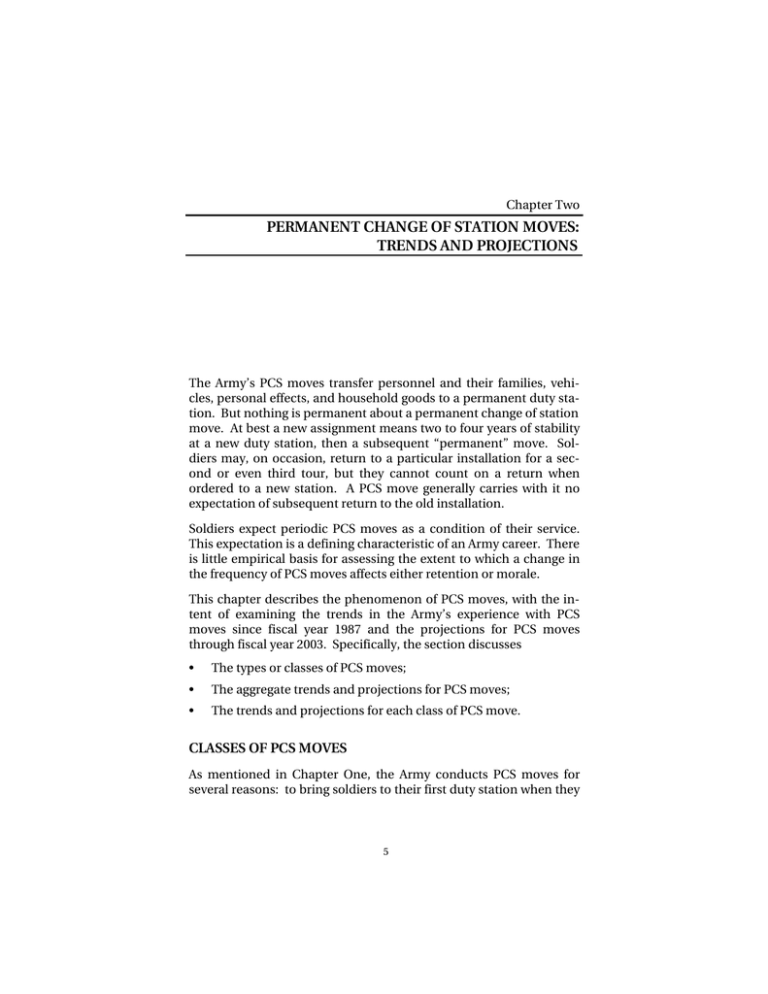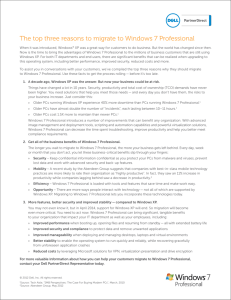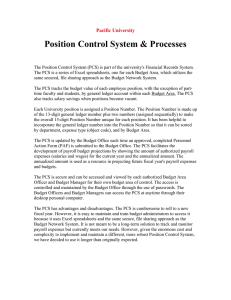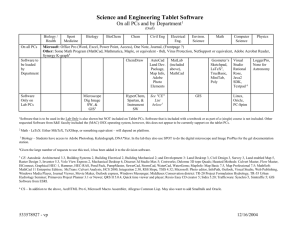PERMANENT CHANGE OF STATION MOVES: TRENDS AND PROJECTIONS
advertisement

Chapter Two PERMANENT CHANGE OF STATION MOVES: TRENDS AND PROJECTIONS The Army’s PCS moves transfer personnel and their families, vehicles, personal effects, and household goods to a permanent duty station. But nothing is permanent about a permanent change of station move. At best a new assignment means two to four years of stability at a new duty station, then a subsequent “permanent” move. Soldiers may, on occasion, return to a particular installation for a second or even third tour, but they cannot count on a return when ordered to a new station. A PCS move generally carries with it no expectation of subsequent return to the old installation. Soldiers expect periodic PCS moves as a condition of their service. This expectation is a defining characteristic of an Army career. There is little empirical basis for assessing the extent to which a change in the frequency of PCS moves affects either retention or morale. This chapter describes the phenomenon of PCS moves, with the intent of examining the trends in the Army’s experience with PCS moves since fiscal year 1987 and the projections for PCS moves through fiscal year 2003. Specifically, the section discusses • The types or classes of PCS moves; • The aggregate trends and projections for PCS moves; • The trends and projections for each class of PCS move. CLASSES OF PCS MOVES As mentioned in Chapter One, the Army conducts PCS moves for several reasons: to bring soldiers to their first duty station when they 5 6 Personnel Turbulence: The Policy Determinants of PCS Moves enter active duty, to return them to their homes of record when they leave active duty, to replace soldiers returning from fixed-length tours outside the CONUS, to send them to schools for longer than 20 weeks, to develop them professionally when needed experience cannot be gained at their current duty stations, to accommodate force and base realignments, to fill requirements that cannot be met with locally assigned personnel, to alleviate imbalances across installations, and to meet soldiers’ personal needs for compassionate reasons. In its financial accounting documents, the Army as well as the other services divide PCS moves into six classes: (1) accession moves; (2) separation moves; (3) rotational moves; (4) training moves; (5) operational moves; and (6) unit moves. Because in a force of a constant size separations drive accessions, we lump accession and separation moves into a single class. Figure 2.1 shows the fiscal year 1997 percentage breakdown of the five classes of moves. Each is discussed in more detail below. Figure 2.1—Percentage Breakout of Classes of PCS Moves, FY97 PCS Moves: Trends And Projections 7 Accession and Separation Moves These two types of moves—whose magnitude in a force of a given size is determined by losses from the force—today constitute 64 percent of PCS moves. Accession moves bring soldiers to their first duty stations; separation moves return soldiers to civilian life when they leave active duty. The number of losses from the force determines the number of separation moves, which, to maintain a constant force size, requires an equal number of accession moves. In a shrinking force, the number of accession moves is smaller than the number of separation moves. In a growing force, the converse is true. In all cases, the greater the average length of service, the fewer the losses and therefore the fewer the required accessions to maintain a constant force size. This leads directly to fewer accession and separation moves. Rotational Moves Rotational moves—moves of soldiers to and from outside continental United States (OCONUS) assignments—constitute a quarter of the Army’s PCS moves. Two factors—the size of the force overseas and the length of overseas tours—drive the number of rotational moves.1 Hence, the overall decline in overseas strengths would lead one to expect a decline in the absolute number of rotational moves. But the Army has reduced its troop strengths most significantly in Europe, where tours last three years, and to a lesser extent in other areas such as Korea, where tours last a year, causing the aggregate number of number of rotational moves to decline to a lesser extent than the total OCONUS end strength. ______________ 1 The Army budgets and programs the initial moves of soldiers whose first duty assignment is overseas as accession rather than rotational moves. Historically, about one-third of accession moves have been to assignments overseas. Such moves are counted as accession moves since they move a soldier to his or her first duty assignment, but because the Army decides to have part of its force structure overseas, these initial moves could also properly be classed as rotational. Similarly, the final moves of soldiers whose last duty station is overseas are counted as separation rather than rotational moves. At any rate, the budgeted and programmed number of rotational moves understates the total number of moves to and from overseas theaters. 8 Personnel Turbulence: The Policy Determinants of PCS Moves Training Moves Training moves, which constitute only 3 percent of the PCS moves, bring soldiers to training courses of 20 weeks duration or greater and send them to their next duty assignments upon completion of their training. Soldiers attend courses shorter than 20 weeks on the basis of temporary duty (TDY) rather than PCS. Training moves are driven by the Army’s skill and leader development requirements. They are largely devoted to moving the officer rather than the enlisted force. About 70 percent of the training moves and three-fourths of their costs are attributable to officer moves. This is due largely to the policy of sending all captains to their advanced courses and majors to command and staff colleges on a PCS rather than TDY basis. The enlisted force conducts most of its professional development training on a TDY basis. Operational Moves Operational moves, which constitute 8 percent of PCS moves, transfer soldiers from one duty station to another within a given theater or within the CONUS. Such moves are driven by the need to correct grade or skill imbalances across geographic locations and to move soldiers who complete assignments of fixed duration (such as recruiting, drill sergeant, instructor, or Reserve Component (RC) support). Unit Moves Unit moves, which constitute less than 1 percent of PCS moves, occur when soldiers move as a part of the relocation of an entire unit. Most recently, such moves have been attendant principally to base realignments and closures. Below we examine aggregate trends for all classes of PCS moves; then we examine the trends for the specific classes discussed above. PCS Moves: Trends And Projections 9 AGGREGATE TRENDS FOR PCS MOVES 2 Since the end of the Cold War, the Army has reduced its active-duty force from almost 800,000 personnel to an anticipated steady state of just under 500,000 in fiscal year 1996.3 As Figure 2.2 shows, the anticipated number of PCS moves has declined as well and roughly in proportion to the end-strength reductions. Specifically, the fiscal year 1997 end strength is expected to decline by 36.8 percent relative to fiscal year 1987, while the number of PCS moves will drop by 36.0 SOURCES: FY87–96 data from U.S. Department of the Army, Budget Estimates, Military Personnel, Army, “actual” columns; FY97–98 data from FY98/99 Budget Estimates, “estimate” columns; FY00–03 data from U.S. Department of the Army, Program Objectives Memorandum, FY98–03, Format F-7. Figure 2.2—Active Army End Strengths and PCS Moves, FY87–03 ______________ 2 This analysis excludes moves of U.S. Military Academy (USMA) cadets, which cost $486,000 in fiscal year 1994. Cadet moves, which are all accession- and separationrelated, are fairly stable in number and cost and are unrelated to the policy issues this report addresses. 3 Further reductions of about 15,000 in active component end strength are planned by the Defense Department but at the time of this writing have not been acted upon by the Congress. 10 Personnel Turbulence: The Policy Determinants of PCS Moves percent. Some in the Army had anticipated a postdrawdown stabilization that would reflect a significantly larger reduction in moves and an associated increase in stability. As shown in Figure 2.2, a freeze in personnel assignments and separations accompanied Operation Desert Storm (ODS) in fiscal year 1991, reducing the number of PCS moves that year. In 1992 the freeze was lifted, breaking the logjam and resulting in a spike of moves and a pronounced decline in end strength that year as soldiers who had been involuntarily extended on active duty or frozen in place in fiscal year 1991 either left the service or moved to their new duty stations. By fiscal year 1997, both end strength and the aggregate number of moves have nearly stabilized. The ratio of PCS moves to end strength shown in Figure 2.3 reveals that the relatively stable force size in fiscal year 1997 and beyond will require about as many moves per end strength as it did during the Cold War. By fiscal year 1997, the enlisted force is expected to experience 0.63 moves per capita, exactly the fiscal year 1987 ratio. The SOURCES: See Figure 2.2. Figure 2.3—Ratio of Moves to End Strength: Officers, Enlisted, and Aggregate, FY87–03 PCS Moves: Trends And Projections 11 officer force will continue to be less mobile than the enlisted force, reflecting officers’ longer lengths of service and, therefore, fewer accession and separation moves per capita. For fiscal year 2000 and beyond, the Army Program Objectives Memorandum (POM) projects only aggregate figures; it does not separate enlisted and officer move projections. The aggregate POM projections are consistent with overall PCS-move rates at about the Cold War rate. In the aggregate, the trend in PCS-move rates will be almost flat. The next section examines trends in the individual classes of PCS moves and the factors that determine those trends. TRENDS BY CLASS OF MOVE Figure 2.4 disaggregates the trend line from Figure 2.2 into the five classes of PCS moves. As the figure shows, accession and separation moves account for more than half the total. Such has been and will continue to be the case throughout the program period. As troop strengths overseas have declined, so have the number of rotational SOURCES: See Figure 2.2. Figure 2.4—Trends in Classes of PCS Moves, FY87–03 12 Personnel Turbulence: The Policy Determinants of PCS Moves moves. Training, operational, and unit moves will continue to represent a small fraction of the total and will decline in absolute number until they stabilize in FY00. Accession and Separation Moves As Figure 2.4 reflects, the post–Cold War reduction in Army end strength substantially reduced the number of loss-driven moves. But as Table 2.1 shows, by fiscal year 1997, when the force stabilizes in size, the officer force requires slightly fewer loss-related moves and enlisted force slightly more relative to end strength than was the case in fiscal year 1987, before the drawdown began. In fiscal year 1987, the 280,800 accession and separation moves shown above equaled about 17 percent and 39 percent of the activeduty officer and enlisted end strengths, respectively, or 36 percent for the force as a whole.4 As Figure 2.5 shows, that percentage rose during the force drawdown of the early 1990s, indicating shorter average Table 2.1 Changes in End Strengths and Loss-Related Moves (End strengths and moves in thousands) FY87 FY97 Officer End strength Loss-related moves Ratio of moves to end strength 108.0 8.1 .17 80.3 13.0 .16 –25.6 –28.2 Enlisted End strength Loss-related moves Ratio of moves to end strength 668.0 262.7 .39 410.7 179.0 .44 –38.5 –31.9 Aggregate End strength Loss-related moves Ratio of moves to end strength 776.0 280.8 .36 491.0 192.0 .39 –36.7 –31.6 ______________ 4 Note that end strengths exclude cadets. % Change PCS Moves: Trends And Projections 13 SOURCES: See Figure 2.2. Figure 2.5—Ratio of Accession and Separation Moves to End Strength durations of service as soldiers were either involuntarily separated or offered financial incentives to leave. In fiscal year 1994, the figure dropped to 33 percent and returned to about 40 percent by fiscal year 1996. This indicates a steady-state future only slightly more turbulent in terms of average length of service than the Cold War era, attributable entirely to marginally shorter expected tenures of the enlisted force. Note the differences between the officer and enlisted rates. 5 Because officers serve from 2 to 2.5 times as long as enlisted personnel, the required replenishment percentage and corresponding proportion of accession and separation moves are substantially lower for officers. The trends of the two groups differ as well. While the enlisted percentages continue to climb through fiscal year 1997, indicating shorter average terms of service, the officer percentages decline slightly, indicating slightly longer terms of service. ______________ 5 Note also in Table 2.1 that the officer force end strength drops by only 26 percent, while the enlisted force is reduced by 39 percent. 14 Personnel Turbulence: The Policy Determinants of PCS Moves In sum, then, by fiscal year 1997, the aggregate number of loss-related moves will decline relative to fiscal year 1987 by less than the relative decline in end strength. Rotational Moves The principal determinants of rotational moves are the size of the force stationed OCONUS and the length of such tours of duty. Generally, in overseas locations such as Germany where soldiers may take their families—so-called accompanied tours—soldiers serve for three years. The relatively small number of soldiers who choose not to take their families to locations where dependents are allowed normally serve for two years. Tours in places where dependents are generally not permitted, such as South Korea, last one year.6 Table 2.2 shows that in fiscal year 1987, the Army had about 290,000 soldiers stationed OCONUS; by fiscal year 1997, that number drops to about 123,000, a decline of 58 percent. Most of the reduction results from cuts in the long-tour (principally European) structure, where the troop strength falls by 64 percent; the number of soldiers stationed in short-tour areas (principally Korea) drops by only 21 percent. Every soldier serving in a short-tour area needs to be replaced every year, while only one-third of those serving in long-tour areas depart each year and therefore require replacement.7 Hence, the large reduction in long-tour authorizations between fiscal year 1987 and fiscal year 1997 carries with it less than a proportional share of reductions in rotational moves. ______________ 6 Some accompanied tours are shorter than three years, while some unaccompanied tours are longer than one year. The numbers, however, are small. Accordingly, for the analysis at hand we make the simplifying assumption that all accompanied tours are three years and that all unaccompanied tours are one year. 7 Assuming, of course, that all soldiers serve full tours and that no soldiers extend their tours. For the purposes of this policy-screening analysis we assume such to be the case. PCS Moves: Trends And Projections 15 Table 2.2 Changes in OCONUS Strengths and Rotational Moves (All figures in thousands) FY87 FY97 % Change Long-tour structure 247.7 89.4 –64 Short-tour structure 42.2 33.4 –21 Total OCONUS structure 289.9 122.8 –58 Rotational Moves 151.7 73.0 –52 SOURCE: Structure figures—Personnel Management Authorizations Document (PMAD); move figures—budget estimates. Other Moves: Operational, Training, and Unit As shown in Figure 2.6, which breaks out the top band of Figure 2.4 into the three classes, each class of move is declining in number from its drawdown peak. Collectively, the three classes are expected to begin to stabilize in fiscal year 1997, reaching a steady state of about 30,000 moves in fiscal year 2000, about 90 percent of the Cold War level. Unit moves decline as drawdown restationing subsides. Training moves decline as the smaller Army requires proportionately less training. Operational moves rise slightly, for a somewhat complex reason. During the Cold War, large overseas strengths provided a large demand for replacements. This demand allowed personnel managers to move soldiers from CONUS assignments of fixed tour lengths (such as recruiting, RC, drill sergeant, or instructor duty) to overseas assignments under rotational moves. Now, as overseas demand has declined, managers must use operational moves rather than rotational moves to reassign many of these soldiers. Training moves. As mentioned above, training moves take soldiers to and from training courses of 20 weeks or greater.8 As shown in Table 2.3, the Army sends many more officers than enlisted personnel to these long courses. Specifically, officers require more than two-thirds of all training moves. An officer is more than ten times as ______________ 8 Soldiers are sent to shorter courses of instruction on TDY rather than as a PCS. 16 Personnel Turbulence: The Policy Determinants of PCS Moves Figure 2.6—Training, Operational, and Unit Moves, FY87–03 likely as an enlisted soldier to move under a training move. A substantial fraction of these officer moves is required to send captains to their advanced courses and to send majors to command and staff colleges. The enlisted force, by contrast, does most of its noncommissioned officer education system (NCOES) training through TDY assignments rather than through PCS moves. While the POM does not show the officer and enlisted split of training moves for fiscal year 2000 and beyond, it projects an aggregate figure of 8,200 from fiscal year 2000–03, a number close to the fiscal year 1997 total (of 6,015 plus 2,700) shown in Table 2.3. Two points can be made about training-move policy changes. First, training moves represent less than 3 percent of all PCS moves. Hence, reducing them will not save a lot of money. Second, because most of the training moves are associated with officer advanced and command and staff college courses, the greatest policy leverage over this class of moves would come from a policy change of conducting most of this training in a distributed mode and then sending officers to shorter phases of these two programs on TDY rather than in a PCS status. But if the Army chose to pursue this policy, increased TDY PCS Moves: Trends And Projections 17 Table 2.3 Training Moves, Percentages, and Rates for Selected Years FY87 FY89 FY91 FY93 FY95 FY97 Officer training moves 7,755 9,114 7,544 8,099 7,150 6,015 Enlisted training moves 4,372 4,315 3,501 3,000 2,800 2,700 Officer training moves as % of total 63.9 67.9 68.3 73.0 71.9 69.0 Enlisted training moves as % of total 36.1 32.1 31.7 27.0 28.1 31.0 Officer end strength (000) 108.0 106.9 106.3 87.8 82.3 80.3 Enlisted end strength (000) 668.4 658.3 614.8 480.4 423.7 410.7 Training moves per 1,000 officers 72 85 71 92 87 75 Training moves per 1,000 enlisted personnel 7 7 6 6 7 7 costs would offset PCS-move savings. Further, the readiness of units whose officers are absent on TDY would suffer. Operational moves. As is the case with training moves, officers experience a disproportionate number of operational moves, but not to the same degree. Table 2.4 shows that in fiscal year 1997, officers will experience almost twice the per-capita operational move rate, 75 per 1,000, as will the enlisted force (41 per 1,000). Many officers move for professional development reasons, others move when their fixed tours, described above, end. The enlisted force has proportionately fewer such demands for moves. Unit moves. As Figure 2.6 showed, the Army predicts that as the drawdown and base realignments subside, unit moves will cease to be a significant source of turbulence. SUMMARY The aggregate trends and projections for PCS moves, as well as the trends and projections within the individual classes of PCS moves, reveal that the absolute number of PCS moves has declined and is 18 Personnel Turbulence: The Policy Determinants of PCS Moves Table 2.4 Operational Moves, Percentages, and Rates for Selected Years FY87 FY89 FY91 FY93 FY95 FY97 Officer operational moves 5,447 4,862 7,252 6,378 4,982 6,027 Enlisted operational moves 13,284 13,804 26,865 15,474 17,000 17,000 Officer operational moves as % of total 29.1 26.0 21.3 29.2 22.6 26.2 Enlisted operational moves as % of total 70.9 74.0 78.7 70.8 77.4 73.8 Operational moves per 1,000 officers 50 45 68 73 61 75 Operational moves per 1,000 enlisted personnel 20 21 44 32 40 41 about to stabilize as the Army reaches postdrawdown stability. But the aggregate per-capita PCS-move rates will remain at about the Cold War level. In particular, accession and separation moves relative to force size will, in the out-years, remain roughly comparable to Cold War levels. To reduce the numbers, the Army would have to increase the duration of soldiers’ service. Although rotational moves, which are driven by overseas strengths and tour lengths, will decline in absolute terms, they will increase relative to overseas strengths, which is the result of disproportionate cuts in long-tour authorizations. Only reductions in authorizations or increases in tour length can reduce the numbers further. Training, operational, and unit moves, which together constitute less than 10 percent of moves, are driven by a number of factors. The most important single factor, however, is officer professional development requirements, principally the requirement to send officers via training moves to and from their advanced courses and command and staff college. Officer professional development needs also drive some operational moves. Given officer end strengths, the greatest policy leverage to reduce training, operational, or unit moves would come from changing policies that now cause officers to attend these courses on a PCS rather than TDY basis. Operational moves represent a more complicated situation; a number of demands generate such moves, both in the officer and the enlisted force. No single policy appears to domi- PCS Moves: Trends And Projections 19 nate. While operational moves represent a small fraction of the total, it may be worthwhile to investigate further the set of policies that drive such moves. To assess differences between the officer and enlisted forces, Table 2.5 summarizes PCS-move rates for fiscal year 1997, in which much of the drawdown turbulence has subsided. Force losses (accession and separation) continue to create the most PCS-move turbulence for both officers and enlisted personnel. The second most important source of turbulence, however, differs for the two forces. For the enlisted force, rotational moves to and from overseas assignments generate the most moves per capita. For the officer force, other moves— principally training and operational—outrank rotational moves as the second most prevalent source per capita. Table 2.5 PCS Moves per 1,000 End Strength, FY97 Officer Enlisted 162 436 97 158 Other (training, operational, unit) 150 52 Total 409 646 Accession and separation Rotational




